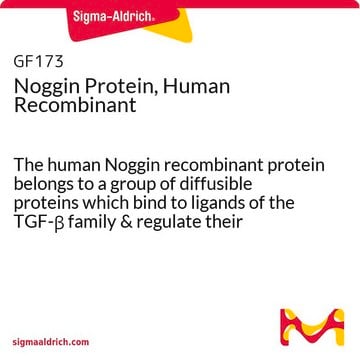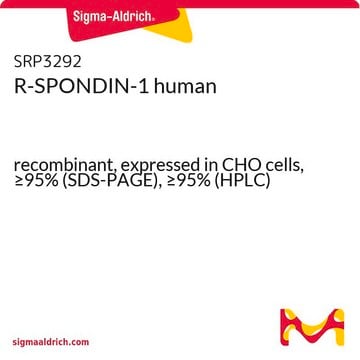H6416
Noggin human
recombinant, expressed in HEK 293 cells, HumanKine®, suitable for cell culture
Sign Into View Organizational & Contract Pricing
All Photos(1)
About This Item
MDL number:
UNSPSC Code:
12352202
Recommended Products
biological source
human
recombinant
expressed in HEK 293 cells
Assay
≥95% (SDS-PAGE)
form
lyophilized powder
potency
≤200 ng/mL ED50
quality
endotoxin tested
mol wt
dimer 65 kDa (glycosylated)
packaging
pkg of 1 mg
pkg of 10 μg
pkg of 100 μg
storage condition
avoid repeated freeze/thaw cycles
technique(s)
cell culture | mammalian: suitable
impurities
≤1 EU/mg
UniProt accession no.
storage temp.
−20°C
Gene Information
human ... NOGG(9241)
Looking for similar products? Visit Product Comparison Guide
General description
A bone morphogenetic protein (BMP) antagonist is coded by noggin. The node, notochord and dorsal somite shows its expression. It possess a cystine-knot domain, having two β-strand finger-like loops.
Application
Noggin human has been used a supplement in 20% complete medium for isolation of crypts, establishment of human enteroid cultures. It has also been used as a growth factor supplement for pancreatic endoderm specification medium.
Biochem/physiol Actions
Noggin is essential for the normal mouse development. Noggin is required for cartilage morphogenesis and joint formation. It is also an inhibitor of bone morphogenic protein (BMPs) signaling, which is necessary for the growth and patterning of neural tube and somites. Studies indicate Noggin may play a critical role in the formation of gradients of BMP activity. Noggin is produced in the mesoderm in developing embryos and has been shown to have a high affinity to BMP binding protein. When Noggin binds to BMPs, inhibition occurs, preventing BMPs from interacting with receptors on the cell surface. Knockout mice lacking expression of Noggin die at birth from multiple defects including bony fusion of the appendicular skeleton. Noggin has a high binding affinity to heparin and heparan sulfate proteoglycans at the cell surface. Heparan sulfate-bound Noggin remains active and capable of binding BMP4 at the plasma membrane. Noggin can also be competitively displaced by heparin when bound to cells that express heparan sulfate proteoglycan.
Noggin is required for cartilage morphogenesis and joint formation. It is also an inhibitor of bone morphogenic protein (BMPs) signaling, which is necessary for the growth and patterning of neural tube and somites. Studies indicate Noggin may play a critical role in the formation of gradients of BMP activity. Noggin is produced in the mesoderm in developing embryos and has been shown to have a high affinity to BMP binding protein. When Noggin binds to BMPs, inhibition occurs, preventing BMPs from interacting with receptors on the cell surface. Studies indicate Noggin plays a critical role in the formation of gradients of BMP activity. Knockout mice lacking expression of Noggin die at birth from multiple defects including bony fusion of the appendicular skeleton.
Noggin has a high binding affinity to heparin and heparan sulfate proteoglycans at the cell surface. Heparan sulfate-bound Noggin remains active and capable of binding BMP4 at the plasma membrane. Noggin can also be competitively displaced by heparin when bound to cells that express heparan sulfate proteoglycan.
Noggin has a high binding affinity to heparin and heparan sulfate proteoglycans at the cell surface. Heparan sulfate-bound Noggin remains active and capable of binding BMP4 at the plasma membrane. Noggin can also be competitively displaced by heparin when bound to cells that express heparan sulfate proteoglycan.
Preparation Note
HumanKine Noggin is expressed in human HEK 293 cells using a scaleable suspension cell culture system. The protein is a highly stable, authentically glycosylated,disulfide linked 65 kDa homodimer. Production in human HEK 293 cells offers authentic glycosylation. Glycosylation contributes to stability in cell growth media and other applications.
Analysis Note
The specific activity was determined by the dose dependent inhibition of rhBMP4 induced alkaline phosphate production by ATDC5 cells.
Legal Information
HumanKine is a registered trademark of Proteintech Group, Inc. and Humanzyme, Inc
Storage Class Code
13 - Non Combustible Solids
WGK
WGK 3
Flash Point(F)
Not applicable
Flash Point(C)
Not applicable
Choose from one of the most recent versions:
Already Own This Product?
Find documentation for the products that you have recently purchased in the Document Library.
Customers Also Viewed
Noggin, Cartilage Morphogenesis, and Joint Formation in the Mammalian Skeleton
Brunet LJ, et al.
Science (New York, N.Y.), 1455-1457 (1998)
Noggin-mediated antagonism of BMP signaling is required for growth and patterning of the neural tube and somite
McMahon JA, et al.
Genes & Development, 12(10), 1438-1452 (1998)
Kongju Zhu et al.
Journal of developmental biology, 11(3) (2023-07-25)
How head patterning is regulated in vertebrates is yet to be understood. In this study, we show that frog embryos injected with Noggin at different blastula and gastrula stages had their head development sequentially arrested at different positions. When timed
The BMP signaling and in vivo bone formation
Cao X, et al.
Gene, 357(1), 1-1 (2005)
The Bone Morphogenetic Proteins and Their Antagonists
Vitamins and Hormones, 99(9), 63-90 (2015)
Our team of scientists has experience in all areas of research including Life Science, Material Science, Chemical Synthesis, Chromatography, Analytical and many others.
Contact Technical Service








![(S)-2-[[3,5-Bis(trifluoromethyl)phenyl]thioureido]-N-benzyl-N,3,3-trimethylbutanamide 97%](/deepweb/assets/sigmaaldrich/product/structures/373/888/118b46f2-6c2e-4a87-8266-c4dbcd5db51f/640/118b46f2-6c2e-4a87-8266-c4dbcd5db51f.png)





